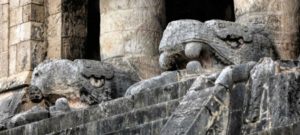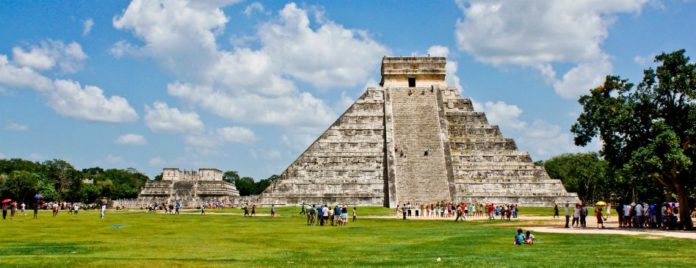This article was featured in Loco Gringo.
Twice a year, at each equinox, the sun plays with the angles of the northeast stairway of the Kukulcán pyramid at Chichen Itza (called El Castillo in Spanish).
The north stairway of the Kukulcán pyramid is the main sacred path that, on its northeast balustrade at the vernal (March) and autumnal (September) equinoxes, the stepped terraces of the pyramid cast triangular shadows. As the sun moves west, the angular shadows give the visual impression of an undulating serpent body crawling slowly down the stairway, and the massive serpent head with mouth agape, at the bottom. The event draws thousands of tourists that gather on the grand plaza to witness the event.

The Kukulcán temple-pyramid is not cardinally oriented; it is believed to mythologically sits at the center of time and space. Its corners lined up on a northeast-southwest axis toward the rising and setting sun at the summer and winter equinoxes, making the pyramid a monumental sundial for the solar year. The four stairways ascending the pyramid, one on each side have 91 steps each, equal 364 steps that, with the temple at the top, total the 365 days, or a solar year.
Kukulcán is the Maya Yucatec name for Quetzalcoatl, god of the Fifth Sun that came with the Toltecs from the central plateau of Mexico and the Itza conquerors. The Toltecs joined Maya Chontal groups from the northwest of the Yucatán peninsula and conquered Chichen Itza,“the city of the water sorcerers,” early in the 10th century.
The vast plaza that surrounds the Castillo on four sides represents the Primordial Sea of Creation, from where is believed all life sprung at the beginning of time. The plaza north side was the area of significant ritual ceremonies, bordered by the Venus Platform, with the Eagle warriors and the Tzompantli or skull rack, behind to it. Beyond is the massive Temple of the Warriors on the east side, and the Ballcourt, to the west.
Chichen Itza’s Spiritual Gateways
Two other portals, or spiritual gateways, are linked to the temple-pyramid, one natural, the other manmade. The first is the enormous sacred cenote, or sinkhole referred to as the “Great Well of the Itzas.” It is reached by a largely elevated such, Maya for white road, heading northward from the Great Plaza and the Venus Platform. The cenote was believed to be the place of communication with the gods of Xibalba, the “Place of Awe” the underworld; it was also Cha’ak dwelling, the powerful Maya god of rain, lightning, and thunder.
The structure built on the lip of the cenote was used to prepare sacrificial victims to the gods. Gifts to the gods were precious jade and metals, very fine ceramics and lives. The archaeological record shows that human sacrifices were of both genders of any age. In a time of dire needs such as persistent drought, a community would sacrifice its best, not the sickly or the maimed; sacrificial victims had to be able and in their prime.
The Great Ballcourt, Second Spiritual Gateway
The second portal, the man-made spiritual gateway, is the Great Ballcourt on the west side of the Great Plaza together with the Temple of the Jaguars and is the largest ballcourt in the Americas. For the ancient Mayas, the ballcourts opened literally into Otherworlds. Ball playing as a ritual was a fateful game destined to end in sacrifice. The metaphor that took place in the ballcourt reflected the tribulations of life, death, evil and disease that defined human destiny and history.

Chichen Itza Still Holds Surprises
There is much more to be said about Chichen Itza and, of course, still far more to be learned we do not know, such as the serpent shadow on the temple-pyramid? Excavations in the Great Plaza started in 2009, revealed buried structures that pre-date Kukulcán. What will we learn from this hidden past before the great temple-pyramid was built, is still to be discovered.
*About the author: George is a Fellow of the Institute of Maya Studies in Miami, FL., as well as the Royal Geographical Society with the Institute of British Geographers, London, U.K., and member in good standing of the Maya Exploration Center, Austin, TX.
Travel tip: If it is a cloudy day there won’t be any shadows to witness. So check the weather first.
This article was originally written for and published by Loco Gringo.















I have an assignment on this and this article helped me get a better grade